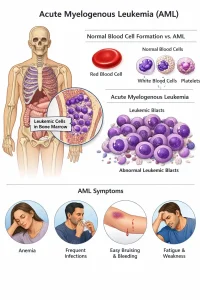Overview
Diagnosis of Acute Myeloid Leukemia
The diagnosis of AML typically begins with a physical exam to check for bruising, mouth or gum bleeding, infection, and swollen lymph nodes. Additional tests help confirm the diagnosis and identify the specific AML subtype.
• Blood Tests: A complete blood count is used to measure the number of blood cells. Results may show too many or too few white blood cells, a low number of red blood cells, and low platelet counts. Another test looks for myeloblasts (immature white blood cells), which are not normally present in healthy blood.
• Bone Marrow Aspiration and Biopsy: These procedures involve collecting samples from the bone marrow, usually from the hip bone. The samples are tested in a lab to look for DNA and chromosomal changes in the cells. This information helps doctors identify the type of AML and create a targeted treatment plan.
• Lumbar Puncture (Spinal Tap): This test may be done if there’s concern the leukemia has spread to the brain or spinal cord. A small needle is inserted into the lower back to collect fluid, which is tested for leukemia cells.
• Imaging Tests: Imaging techniques like CT scans, MRI, or PET scans may be used if there’s concern the leukemia has spread to other parts of the body, including the brain.
Understanding Your AML Subtype
After diagnosis, further lab tests are done to determine the AML subtype. These tests examine the blood and bone marrow for genetic mutations and other specific changes. There are currently 15 recognized AML subtypes, and knowing the subtype is crucial to selecting the most effective treatment.
Treatment for Acute Myeloid Leukemia
Treatment for AML depends on several factors — including the subtype, age, overall health, and personal preferences. It typically has two main phases:
• Remission Induction Therapy: The goal is to kill as many leukemia cells as possible in the blood and bone marrow. This phase often involves intensive treatment to bring the disease into remission.
• Consolidation Therapy: Also known as post-remission therapy or maintenance therapy, this phase targets any remaining leukemia cells to reduce the risk of relapse.
Treatment Options for AML
• Chemotherapy: Chemotherapy is the primary treatment for AML. It uses powerful medicines, usually given intravenously, to destroy leukemia cells. Most patients remain in the hospital during this treatment because healthy blood cells are also affected. If remission is not achieved after the first cycle, additional cycles may be needed. Side effects can include nausea, hair loss, and increased infection risk.
• Targeted Therapy: Targeted therapy uses medicines that attack specific genetic or chemical changes in leukemia cells. It may be used alone or with chemotherapy during induction therapy.
• Bone Marrow Transplant: Also known as a stem cell transplant, this treatment replaces damaged bone marrow with healthy donor stem cells. Before the transplant, high-dose chemotherapy or radiation is given to destroy diseased bone marrow. The new stem cells then help restore healthy blood production. This is typically an allogeneic transplant (from a donor).
• Clinical Trials: Some patients choose to participate in clinical trials, which offer access to new or experimental AML treatments. Clinical trials may include innovative drug combinations or novel therapies.
Key Takeaway
Acute myeloid leukemia is a serious but treatable cancer. Early detection, accurate subtype classification, and a personalized treatment plan can significantly improve outcomes. With advances in targeted therapy, bone marrow transplantation, and clinical research, more effective treatments for AML continue to emerge.
Advertisement

